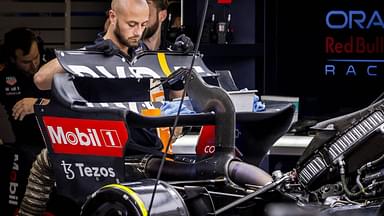The FIA has finally revealed the details of the 2026 regulations reset that will bid adieu to the DRS (Drag Reduction System). DRS, which was first introduced to the sport back in the 2011 season, will now be replaced with another innovation.
The introduction of DRS was seen as a revolutionary move by the sport. In essence, this allowed the drivers to open a slot in their rear wing with the help of a button press, and allow them an aerodynamic advantage over the car ahead – thereby handing them an overtaking advantage.
A car with this aid activated can reach up to 217 miles per hour on the straights. But, as the FIA revealed earlier on Thursday, DRS is going to be replaced by a new system of ‘active aero’ which would provide chasing drivers with more impetus and opportunity to execute overtaking maneuvers during race day.
The new blueprint of the 2026 FIA Formula 1 car through every angle ️✨ This concept and the 2026 FIA Formula 1 regulations are set to redefine speed, performance, sustainability and safety on track.
Get all the info on https://t.co/vRtFSSO8ua@F1 #FIA pic.twitter.com/FJqSLc4NUS
— FIA (@fia) June 6, 2024
According to the explanation given by the governing body of the sport, from 2026 onwards, drivers will have the option to configure their cars to a ‘high downforce‘ and ‘low downforce‘ spec on the fly. This is all thanks to the new active aero arrangement.
Active aero system to replace DRS for 2026 and beyond
The active aero system introduced by the FIA is going to be a lot different than DRS. While the DRS was used as an overtaking aid, the active aero mechanism is going to be more of a strategic tool embedded in the race-craft skills of each driver.
For instance, the one-second restriction will not be applicable to the active aero modes that the drivers can choose. However, like DRS, each circuit is going to have designated zones where the drivers can engage the low downforce spec on their cars.
Formula 1 was already high-speed chess. But with the advent of the 2026 regulations, the drivers will have even more tools at their disposal to get the most out of their machinery. In essence, the low downforce configuration will allow the drivers to reach maximum speeds on the straights.
On the other hand, the high downforce mode will be run through corners, and this will give them the most aerodynamic grip. The replacement of DRS with active aero, however, does not mean that drivers will not have overtaking aids at their disposal.
2026 regulations envisage a 50-50 hybrid F1 power unit
The power unit side of things is going to see a massive overhaul with the latest regulations. One such change is the distribution of engine power.
From 2026 onwards, the Battery Pack and the ICU will have a 50-50 deployment rate. This means there is going to be more electrical power at the drivers’ disposal.
Hence, in place of DRS, the FIA has introduced a manual override button for each chasing driver who is within one second behind the car in front. This will deploy an extra oomph of power – much like a temporary party mode, which chasing drivers can deploy in designated zones on the track.
F1 already has something similar in place with the ERS (Energy Recovery System). However, this time around, the override button would be available only to the drivers chasing a rival on track. More importantly, with almost a 300% increase in battery power, this can be considered like an Overtake Button.
What else is in store for 2026?
Apart from active-aero and a completely overhauled power unit, the sport has also introduced many other changes aimed at making F1 racing even more competitive and exciting. One such change is something that fans and drivers alike have been hoping for a long time.
In its release, the FIA debuted the concept of ‘nimble cars’. Essentially, the 2026 F1 cars are going to be 30 Kgs lighter. This would not only make the cars more agile but also faster in a straight line. Currently, 10 Kgs cost around 0.3-0.4 seconds per lap.
| Williams car overweight, costing 0.45s per lap!
James Vowles: “The transformation we did between 2023 to ’24 took 14 kilos out of the chassis.”
“For anyone in the business, that’s an extraordinary feat.”
“The car this year is about four and a half tenths a lap sower,… pic.twitter.com/8k0MChUuEb
— F1News.live (@f1newslive_) May 17, 2024
Lighter cars and more powerful engines are going to make the latest generation of F1 cars some of the fastest in history. Naturally, the FIA has also revamped the Safety mandates in this regard.
The 2026 F1 cars would have stronger structures and more rigorous tests to be homologated to FIA-spec. The 2026 power units will also be using 100% sustainable fuels.
Lastly, F1 has always been the battle of the Constructors. However, with the introduction of massive overhauls to the power unit side, the sport has been able to lure six engine manufacturers into the fray for the long term – Ferrari, Mercedes, Renault, Audi, Honda, and Red Bull-Ford Powertrains.



